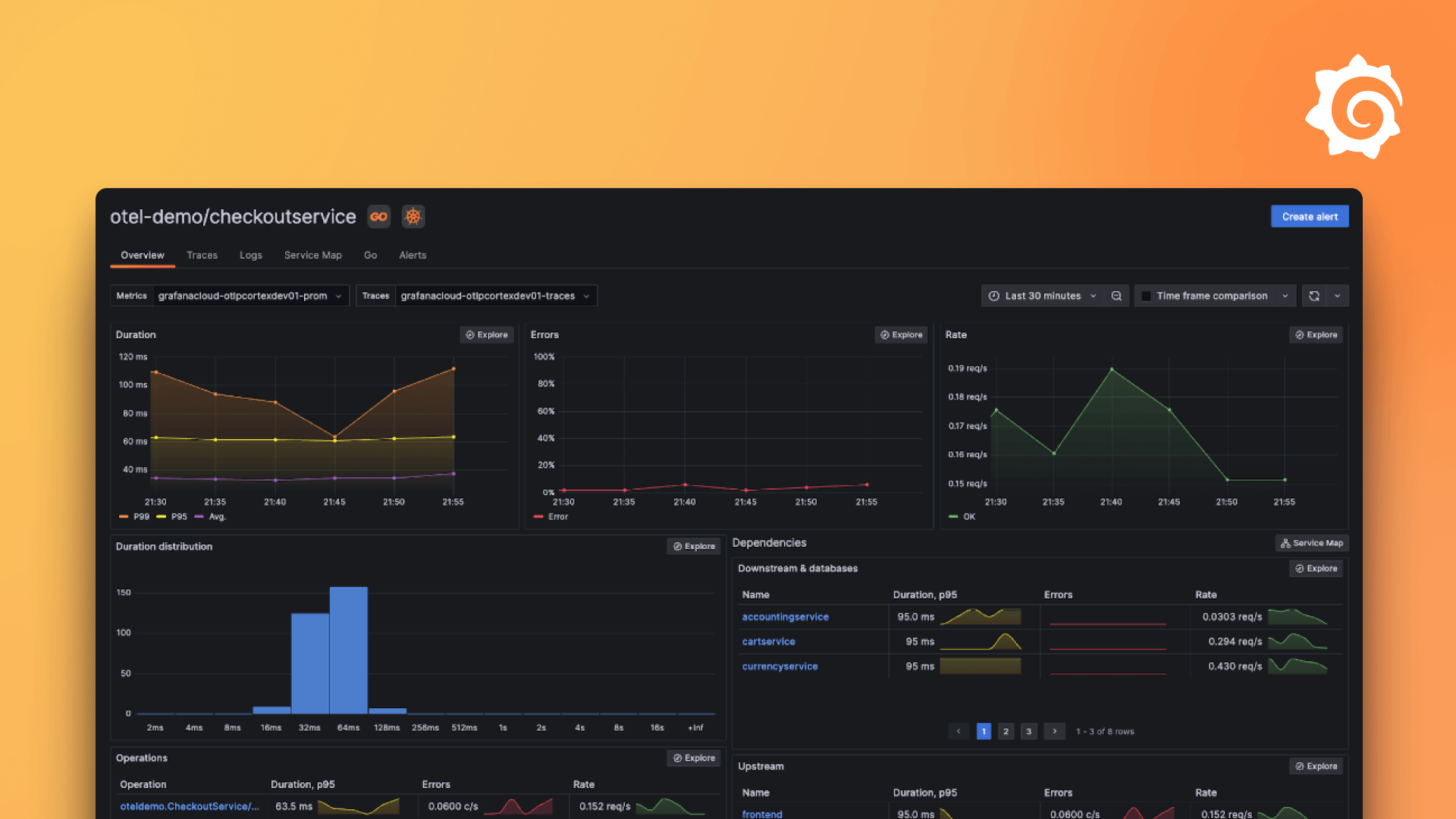Beyla 和 Kubernetes 快速入门
Kubernetes 已完全集成到 Beyla 的运行模式中。
一方面,指标和追踪可以利用运行自动插桩服务的 Kubernetes 实体的元数据进行装饰。
另一方面,DaemonSet 已成为 Beyla 首选的部署模式:得益于新的服务选择器的多功能性,用户可以精确定义哪些服务需要插桩,哪些不需要。Beyla 的单个实例将能够插桩单个 Kubernetes 节点中选定的服务组。
Beyla 服务选择器
服务选择器是一组属性,允许 Beyla 查询哪些进程需要进行插桩。
当 Beyla 作为常规操作系统进程部署以插桩其他进程时,唯一的服务选择器是插桩进程应监听的网络端口(可以通过 `BEYLA_OPEN_PORT` 环境变量指定),或者是一个用于匹配要插桩进程的可执行文件名的正则表达式(`BEYLA_EXECUTABLE_NAME` 环境变量)。
要选择多个进程组,Beyla YAML 配置文件格式提供了 `discovery.services` 部分,该部分接受多个选择器组
discovery:
services:
# Instrument any process using the ports from 8080 to 8089
- open_ports: 8080-8089
# Instrument any process whose executable contains "http"
- exe_path: "http"
# Instrument any process with an executable containing "nginx"
# and using the port 443 (both conditions must be fulfilled)
- open_ports: 443
exe_path: "nginx"上述标准对于 Kubernetes Pod 不够充分,因为 Pod 中的端口是临时的且内部的。此外,Pod 是一个抽象层,应该隐藏其可执行文件名称等细节。因此,Beyla v1.2 引入了新的 Kubernetes 服务选择标准。它们都接受 Go RE2 语法正则表达式 作为值
k8s_namespace: 仅插桩命名空间与提供的正则表达式匹配的应用程序。k8s_deployment_name: 仅插桩名称与提供的正则表达式匹配的 Deployment 中的 Pod。k8s_replicaset_name: 仅插桩名称与提供的正则表达式匹配的 ReplicaSet 中的 Pod。k8s_pod_name: 仅插桩名称与提供的正则表达式匹配的 Pod。
示例场景
1. 部署可插桩的测试服务
您可以插桩 Kubernetes 集群中的任何 HTTP 或 HTTPS 服务。如果愿意,可以先尝试插桩此示例中提供的虚拟服务。
以下 Kubernetes 示例文件包含两个 Apache HTTP 服务器:一个模拟公司**网站**,另一个模拟**文档**站点(`docs`)。请忽略这两个服务器在请求根目录时仅返回“It Works!”字符串,而在请求任何其他路径时返回 404 错误的事实。
将以下内容复制到文件(例如,`sampleapps.yml`)中,并使用命令 `kubectl apply -f sampleapps.yml` 进行部署。
kind: Deployment
apiVersion: apps/v1
metadata:
name: docs
spec:
replicas: 2
selector:
matchLabels:
app: docs
template:
metadata:
labels:
app: docs
spec:
containers:
- name: docs-server
image: httpd:latest
ports:
- containerPort: 80
protocol: TCP
name: http
---
apiVersion: v1
kind: Service
metadata:
name: docs
spec:
selector:
app: docs
ports:
- protocol: TCP
port: 80
---
kind: Deployment
apiVersion: apps/v1
metadata:
name: website
spec:
replicas: 2
selector:
matchLabels:
app: website
template:
metadata:
labels:
app: website
spec:
containers:
- name: website-server
image: httpd:latest
ports:
- containerPort: 80
protocol: TCP
name: http
---
apiVersion: v1
kind: Service
metadata:
name: website
spec:
selector:
app: website
ports:
- protocol: TCP
port: 80要测试它们是否正在运行,请打开两个终端会话,并在不同的会话中运行以下命令中的一个:
# Redirect website to local port 8080
kubectl port-forward services/website 8080:80
# Redirect docs site to local port 8081
kubectl port-forward services/docs 8081:80从您的计算机上,每个对 `https://:8080` 的请求将是针对公司网站的假设请求,而每个对 `https://:8081` 的请求将是针对文档网站的假设请求。
2. 创建 `beyla` 命名空间
在配置和部署 Beyla 之前,让我们创建一个 `beyla` 命名空间。我们将把所有与之相关的权限、配置和部署都集中到这里。
kubectl create namespace beyla3. 获取 Grafana Cloud 凭据
Beyla 可以将指标和追踪导出到任何 OpenTelemetry 端点,也可以将指标作为 Prometheus 端点公开。但是,我们建议使用 Grafana Cloud 中的 OpenTelemetry 端点。您可以在 Grafana 网站上获取免费的 Grafana Cloud 账户。
在 Grafana Cloud 门户中,找到**OpenTelemetry** 方框并单击**配置**。

在**密码 / API 令牌**下单击**立即生成**,然后按照说明创建默认 API 令牌。
**环境变量**将填充一组标准的 OpenTelemetry 环境变量,这些变量将提供 Beyla 的连接端点和凭据信息。

从**环境变量**部分,复制 OTEL_EXPORTER_OTLP_ENDPOINT 和 OTEL_EXPORTER_OTLP_HEADERS 的值,并从中创建一个新的 Secret。例如,创建以下 Secret 文件并应用它
apiVersion: v1
kind: Secret
metadata:
namespace: beyla
name: grafana-credentials
type: Opaque
stringData:
otlp-endpoint: "https://otlp-gateway-prod-eu-west-0.grafana.net/otlp"
otlp-headers: "Authorization=Basic ...rest of the secret header value..."4. 配置并运行 Beyla
接下来,您需要为 Beyla 提供权限,以观察和检查 Beyla 发现机制所需的各种 Kubernetes 资源的元数据。您必须创建以下 YAML 文件并应用它
apiVersion: v1
kind: ServiceAccount
metadata:
namespace: beyla
name: beyla
---
apiVersion: rbac.authorization.k8s.io/v1
kind: ClusterRole
metadata:
name: beyla
rules:
- apiGroups: [ "apps" ]
resources: [ "replicasets" ]
verbs: [ "list", "watch" ]
- apiGroups: [ "" ]
resources: [ "pods", "services", "nodes" ]
verbs: [ "list", "watch" ]
---
apiVersion: rbac.authorization.k8s.io/v1
kind: ClusterRoleBinding
metadata:
name: beyla
subjects:
- kind: ServiceAccount
name: beyla
namespace: beyla
roleRef:
apiGroup: rbac.authorization.k8s.io
kind: ClusterRole
name: beyla现在,通过创建以下 Kubernetes 实体来部署 Beyla
- 一个存储
beyla-config.ymlBeyla 配置文件(定义服务发现标准)的ConfigMap。为了验证 Beyla 即使在运行相同的镜像和可执行文件时也能按服务实例进行区分,Beyla 已配置为**仅**选择docsApache Web 服务器。 - 一个提供 Beyla Pod 及其配置的 Beyla
DaemonSet- 根据
BEYLA_CONFIG_PATH环境变量的指定,从ConfigMap加载beyla-config.yml文件。 - 引用
grafana-secrets中用于端点和凭据的值。 - 使用
beylaServiceAccount获取所有权限。
- 根据
复制并部署以下 YAML 文件
apiVersion: v1
kind: ConfigMap
metadata:
namespace: beyla
name: beyla-config
data:
beyla-config.yml: |
# this is required to enable kubernetes discovery and metadata
attributes:
kubernetes:
enable: true
# this will provide automatic routes report while minimizing cardinality
routes:
unmatched: heuristic
# let's instrument only the docs server
discovery:
services:
- k8s_deployment_name: "^docs$"
# uncomment the following line to also instrument the website server
# - k8s_deployment_name: "^website$"
---
apiVersion: apps/v1
kind: DaemonSet
metadata:
namespace: beyla
name: beyla
spec:
selector:
matchLabels:
instrumentation: beyla
template:
metadata:
labels:
instrumentation: beyla
spec:
serviceAccountName: beyla
hostPID: true # mandatory!
containers:
- name: beyla
image: grafana/beyla:latest
imagePullPolicy: IfNotPresent
securityContext:
privileged: true # mandatory!
readOnlyRootFilesystem: true
volumeMounts:
- mountPath: /config
name: beyla-config
- mountPath: /var/run/beyla
name: var-run-beyla
env:
- name: BEYLA_CONFIG_PATH
value: "/config/beyla-config.yml"
- name: OTEL_EXPORTER_OTLP_ENDPOINT
valueFrom:
secretKeyRef:
name: grafana-credentials
key: otlp-endpoint
- name: OTEL_EXPORTER_OTLP_HEADERS
valueFrom:
secretKeyRef:
name: grafana-credentials
key: otlp-headers
volumes:
- name: beyla-config
configMap:
name: beyla-config
- name: var-run-beyla
emptyDir: {}另请注意
- 要在 DaemonSet 模式下运行,Beyla 需要访问节点中的所有进程。因此,Beyla Pod 需要以
hostPID: true运行。 - Beyla 容器需要以
privileged: true运行,因为它需要执行特权操作,例如加载 BPF 程序和创建 BPF 映射。要将 Beyla 作为unprivileged容器运行(即不带privileged: true选项),请访问部署非特权 Beyla 指南。
5. 测试您的插桩服务并在 Grafana 中查看结果
在前一步骤的 kubectl port-forward 命令仍在运行的情况下,测试两个 Web 服务器实例。例如
curl https://:8080
curl https://:8080/foo
curl https://:8081
curl https://:8081/foo有些请求会返回 404 错误,但这没关系,因为它们也已被插桩。
现在,转到 Grafana Cloud 中的实例,并在左侧面板的**探索**部分,选择用于追踪的数据源(通常命名为 grafanacloud-<您的用户名>-traces)。

要搜索所有追踪,请在查询栏中选择**搜索**框,保持表单为空,然后单击**运行查询**

这将显示 docs 实例(端口 8081)的追踪。您可能会看到来自您自己服务的追踪,但不应看到来自 website 服务的追踪,因为它没有被 Beyla 插桩。

在追踪详细信息中,追踪的资源属性通过运行插桩服务的 Kubernetes Pod 的元数据进行装饰




